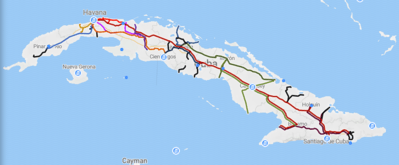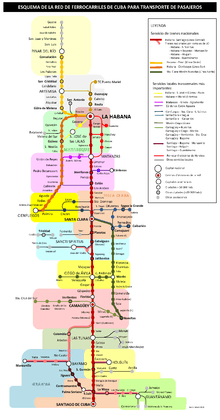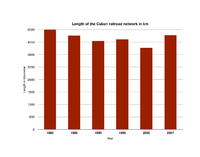Ferrocarriles de Cuba
Ferrocarriles de Cuba (FCC) or Ferrocarriles Nacionales de Cuba (English: National Railway Company of Cuba), provides passenger and freight services for Cuba.
| Ferrocarriles de Cuba | |
|---|---|
| Operation | |
| National railway | FFC (also: FC, FFCC) |
| Statistics | |
| Ridership | 6.7 million (2018)[1] |
| System length | |
| Total | 4,226 km (2,626 mi) |
| Electrified | 140 km (87 mi) |
| Track gauge | |
| Main | 1,435 mm (4 ft 8 1⁄2 in) standard gauge |


Route network
Ferrocarriles de Cuba uses 1,435 mm (4 ft 8 1⁄2 in) standard gauge that extends from Guane (province Pinar del Río) in the westernmost part of the island up to the bay of Guantánamo in the eastern part. The 835 kilometers (519 mi) central railway runs from Havana to Santiago de Cuba in the eastern region. Most of the 4,226 kilometers (2,626 mi) system is diesel powered with 140 kilometers (87 mi) electrified. The flagship Train Number 1 travels between Havana and Santiago de Cuba. Other long distance passenger services link Havana to Pinar del Río (western railway), Cienfuegos (South branch), Sancti Spiritus, Bayamo-Manzanillo and Guantanamo. The network connects the six first level ports in Cuba: Havana, Mariel, Matanzas, Cienfuegos, Nuevitas and Santiago de Cuba, as well as all province capital cities.
The Hershey Electric Railway is an electrified railway from Havana to Matanzas that was built by the Hershey Company in order to transport workers and products after it had bought sugar plantations in 1916. It is a commuter service running in northern Havana and Matanzas provinces using some original equipment.[2]
History
Colonial Cuba
In 1836 Gaspar Betancourt Cisneros established a horse-drawn railway service called Ferrocarril de Camagüey a Nuevitas in Camagüey (Puerto Príncipe).
Cuba's railway history began on October 12, 1834, when the Queen Regent of Spain, Maria Christina of the Two Sicilies, approved the building of the first line. When the Compañia de Caminos de Hierro de la Habana opened the 27.5 kilometers (17.1 mi) line from Havana to Bejucal on November 19, 1837, the first steam railway line in Latin America. At that date Spain itself did not possess any railway lines.
The line from Havana was extended by 17 kilometers (11 mi) to reach Güines on November 19, 1839. By December 1843 the cities San Felipe and Batabanó were added to the rail network. Further extensions were opened in 1847, adding another 17 kilometers (11 mi), followed by 21 kilometers (13 mi) the next year and then 21 kilometers (13 mi) in 1849.
Havana had its first streetcar (Ferrocarril Urbano de la Habana) when its service commenced on February 3, 1859.
Pre-Revolutionary Cuba

American-born Canadian railway builder Sir William Cornelius Van Horne helped expand Cuba's railway network in the early 20th century. He was an investor in the Cuba Railroad Company (founded 1900).
In 1924 Ferrocarriles Consolidados de Cuba was created from a dispute between Ferrocarriles Consolidados de Cuba and Ferrocarriles de Cuba.
Other railway companies formed and merged in the 1920s:
- Ferrocarriles del Norte de Cuba 1916
- Ferrocarril Espirituano Tunas de Zaza
- Ferrocarril Guantánamo y Occidente
From 1940 to 1959, Cuba's railway system was modernized by the acquisition of train stock from Budd and Fiat. These trains provided medium-speed self-propelled (diesel) four-car service on the main line between Havana and Santiago de Cuba. Also after World War II, a large network of diesel intercity buses was created with four or five major carriers competing in the east–west corridor between Havana and the provinces to the east.
A few sugar factories switched over to diesel electric locomotives to haul freight. In 1958, Cuba had more railway trackage per square mile than any other country.
Train ferry
- Prior to the revolution there was a train ferry between Miami and Havana.
- The West India Fruit and Steamship Company was one of a number of companies to provide such service.
Post-revolutionary Cuba

The destruction of President Fulgencio Batista's so-called armoured train (it seems to have been an ordinary train carrying soldiers and weapons) by the revolutionaries in the Battle of Santa Clara in December 1958 was an important stepping stone in the Cuban revolution.
After the revolution in 1959, the Ferrocarriles Nacionales de Cuba was created by nationalizing the private and public railway systems. MINAZ continued to operate a separate railway system, mainly to transport sugar products.
From 1963 to 1966, British Rail helped the national railway obtain newer locomotives which were based on the Brush Type 4 locomotives (later Class 47) at the time being built at Brush Traction in Loughborough, but the final assembly of the Cuban locomotives was performed at Clayton Equipment Company Hatton, Derbyshire.[3] After the Cuban Missile Crisis, it became harder for Cuba to buy new railway equipment because of the United States embargo against Cuba. Some trains were shipped from third countries, British locomotives were shipped from Hull using Yugoslavian ships.
Cuba's purchase of new trains and parts from the Western Bloc, stopped from the late 1960s, was replaced through trade with the Eastern Bloc. The Soviet Union delivered 107 TE-114K locomotives between 1978 and 1984 but this trade link collapsed with the fall of the Soviet Union.
Cuba was able to obtain used trains and new locomotives, from friendly nations not affected by the embargo:
- 5 RSC18 locomotives were shipped from Canada
- 9 electrical motor coaches were shipped from Ferrocarrils de la Generalitat de Catalunya (FGC) (Catalan Government Railways) of Spain
Many of Cuba's trains are diesel and only a handful of steam locomotives remain for the sugar industry and tourism.
Recent developments
Starting in 2000, the Cuban railway network was improved by more second-hand equipment. Used vehicles came from Canada, China, Mexico, and Europe. In 2002 used light rail-cars (BR771) were acquired from Germany.
In 2006 China became Cuba's major supplier of railway equipment. China Northern's February 7 Locomotive Works in Beijing began delivering 12 DF7G-C diesel locomotives. Follow-up orders for 40 and 60 more meant 112 locomotives were delivered between 2006 and 2010. China Railway also sold some of its retired cars.[4]
On September 25, 2007, investors from the Venezuelan Bank for Socio-Economic Development (BANDES) reached an agreement with transportation officials in Cuba to invest US$100 million for infrastructure improvements and repairs to Cuba's rail network. The work was expected to help increase the average speed of trains on Cuba's railways from 40 to 100 kilometers per hour (25 to 62 mph). As part of the agreement, Cuban engineers will also work on similar projects on Venezuela's rail network.[5]
In October 2007, the Cuban railways ordered 200 passenger and 550 freight cars from Iranian manufacturer Wagon Pars. They were delivered by 2009.[6]
In May 2010 the Cuban government announced wide-ranging plans to repair the railway network, buy new rolling stock, and open four centers to train railway workers.[7]
Improved Relations between Cuba and the United States has increased interest in Cuban rail travel.[8] However, in 2017 a new US administration imposed more sanctions.[9]
In 2016 Russian manufacturer Sinara Transport Machines signed a contract for 60 TGM8KM (ТГМ8КМ) and fifteen TGM4KM (ТГМ4КМ) diesel locomotives to be delivered in small lots by the end of 2021. The TGM8KM has been designed especially to work in the humid tropical climate conditions of Cuba. New spare parts for older Russian locomotives will be part of the order. Sinara will also begin rebuilding older locomotives.[10]
In March 2017 Russian manufacturer RM Rail, who had just delivered 363 freight cars, signed a contract to deliver an additional 225. They also contracted for twenty-eight four-car passenger train-sets. In September Russian Railways subsidiary RZD International signed a contract for modernizing the system.[11][12]
In March 2018 France's SNCF entered into an agreement to supply equipment, upgrade two shops to modern standards, and train people in both Cuba and France. Training will include repairing and renovating older equipment.[13]
In August 2018 a decree-law updated and organized the railroad laws and regulation. From September 2018 foreign corporations can operate rail lines. A Safety Commission and other administration changes were made. Part of long-term infrastructure improvements include every track having a right-of-way of at least 15 meters for railroad use only. Any land that borders it must keep a fence in good condition.[14]
As of January 2019, Sinara Transport Machines had delivered 43 diesel locomotives to Cuba as part of a contract to supply 75 locomotives by the end of 2021. A new contract for 23 LDE-2500 diesel locomotives was signed in January 2019. Prototype four-unit DMU rail-cars are being received.[15][16][17][18]
In 2019, the Cuban railways received the first delivery of new Chinese-built coaches, and new services with these began in July 2019.[19][20]
Rolling Stock
| Model | Manufacturer | Country | Total | Notes | Image |
|---|---|---|---|---|---|
| G8[21] | General Motors Electro-Motive Div. |
USA | 51 | Delivered 1954–1955. Similar to Indonesia #200 05 shown 1,100 kW (1,500 hp) B-B |
.jpg) |
| TEM2/4/15[22] | Bryansk Engineering Works |
USSR | 144 | Delivered from 1964 Similar to #3157 shown 883 kW (1,200 hp) C-C |
.tif.jpg) |
| DVM-9[23] | Ganz–MÁVAG | Hungary | 70 | Delivered in 1968 Similar to DVM4 #VME 1-116 shown 450 kW (600 hp) 1A-A1 |
_Haapsalus_(cropped).jpg) |
| M62K[24] | Voroshilovgrad Locomotive Factory |
USSR | 20 | Imported in 1975 Similar to Soviet #0093 shown 1,260 kW (1,690 hp) C-C |
.tif.jpg) |
| MX624[25] | Montreal Locomotive Works |
Canada | 50 | Imported in 1976 1,800 kW (2,400 hp) C-C |
|
| TE114K[26] | Voroshilovgrad Locomotive Factory |
USSR | 108 | Delivered 1978-1984 1,910 kW (2,600 hp) C-C | |
| GMD1 | General Motors Electro-Motive Div. |
Canada | 20 | From Canadian National in 1999 890 kW (1,200 hp) B-B |
.png) |
| C30-7 | GE Transportation Systems | USA | 19 | From Mexico Similar to A.L.L. #9220 shown 2,200 kW (3,000 hp) C-C |
.jpg) |
| 040-DE[27] | Brissonneau et Lotz | France | 42 | Similar to SNCF BB #63123 shown 450 kW (600 hp) B-B |
 |
| DF7K-C | CNR Beijing Locomotive Works |
China | 5 | Delivered in 2008 1,000 kW (1,400 hp) B-B |
|
| DF7G-C[28] | CNR Beijing Locomotive Works[29] |
China | 152 | Delivered 2005–2010 Similar to CR #5036 shown 1,840 kW (2,470 hp) C-C |
|
| TGM4[30] | Lyudinovsky Locomotive Plant |
USSR | 15 | Delivered from 2017.[31] Similar to Russian #0957 shown 599 kW (814 hp) B-B |
_(cropped).jpg) |
| TGM8[32] | Lyudinovsky Locomotive Plant |
USSR | 60 | Delivered from 2017.[31] 882 kW (1,200 hp) C-C |
.jpg) |
| RDC DMU[33] | Budd Co. | USA | 26 | Delivered 1952-1959 Similar to LVRR #40 shown Passengers (RDC-1): 90 |
.jpg) |
| DR VT 2.09[34] railbuses |
Waggonbau Bautzen | GDR | 57 | 771-772-791-792 series Passengers: 40-54 |
 |
| Tempo Coaches |
Hawker Siddeley Canada |
Canada | From Mexico Similar to Rio Grande car shown Passengers (coach): 80 |
||
| TEE Mistral 69 Coaches |
France | From SNCF | |||
| NSB Y1 DMU | Kalmar Verkstad | Norway | 6 | From Norwegian State Railways Passengers: 68-76 |
 |
| Coaches | Wagon Pars | Iran | 200 | Delivered 2007-2009 | |
| SV-10 DMU[35] | Muromteplovoz. | USSR | 300 | Prototypes delivered from 2013[36] Passengers: 45-48 |
Freight cars were mainly acquired from Eastern Bloc countries and the USSR, whereas passenger cars from other countries that have diplomatic relations with Cuba (Mexico, Norway, Canada and France).[37]
See also
- Camagüey railway station
- Ferrocarril Recreacional[38] (located in Parque Lenin) (Closed)
- Havana Central railway station
- Havana Suburban Railway
- Santa Clara railway station
- Santiago de Cuba railway station
- Tren Francés
- Transportation in Cuba
References
- "Gov't Seeks To Revive Once-Great Rail Network". 24 May 2019.
- Morrison, Allen (2008). "The Hershey Cuban Railway". Retrieved February 16, 2008.
- Ram, Thunderbuck. "Cuba". Class47.co.uk.
- "Cuban diesels shipped from China". Railway Gazette. June 20, 2008. Retrieved January 26, 2019.
- "Cuba to Develop Railroad System with Venezuelan Assistance". Cuban News Agency (ACN). September 25, 2007. Retrieved September 25, 2007.
- "World rolling stock market September 2009". Railway Gazette. September 17, 2009. Retrieved January 20, 2019.
- "Cuba to repair national network?". IRJ. 2010. Archived from the original on May 21, 2010. Retrieved May 14, 2010.
- Marsh, Rene (September 30, 2016). "Waiting for the train in Cuba". CNN.
- "Trump Tightens Cuba Embargo Restricting Access to Hotels and Businesses". The New York Times. November 8, 2017. Retrieved January 19, 2019.
- "Major Russian investment planned for Cuba's railways". The Railway Magazine. June 3, 2017. Retrieved January 20, 2019.
- "RM Rail signs Cuban wagon contract". Railway Gazette. March 11, 2017. Retrieved January 20, 2019.
- "Cuba and RZD agree railway modernization". Railway Gazette. September 23, 2017. Retrieved January 26, 2019.
- "France's SNCF Deal to Revitalize the Cuban Railway". Cuban Business Report. January 3, 2019. Retrieved January 19, 2019.
- "New legal rules and regulations for the Cuban railway system". Cuban News Agency (ACN). August 22, 2018. Retrieved January 19, 2019.
- "Russian diesel locomotives arrive in Cuba". RT. February 23, 2018. Retrieved February 23, 2018.
- Verzhbolovich, Anna (March 19, 2017). "Новости АО "ЛТЗ": Тепловоз нового поколения (JSC "LTZ" News: Locomotive of new generation)". Official website. АО «ЛТЗ». Retrieved March 19, 2017.
- "Strong boost to the Cuban railway system in 2019". CMHW Radio (from ACN). January 4, 2019. Retrieved January 19, 2019.
- "Cuba and TMH sign locomotive contract". Railway Pro. January 25, 2019. Retrieved January 26, 2019.
- "Cuba takes first step in railways upgrade with Chinese, Russian help". Reuters. July 13, 2019. Retrieved January 31, 2020.
- "New trains will start operating in Cuba with lower prices than for buses". OnCubaNews. July 9, 2019. Retrieved January 31, 2020.
- "EMD G8 and GA8". thedieselshop. 2006. Retrieved March 1, 2019.
- "SM48 / TEM2". WebRing. 2019. Retrieved March 1, 2019.
- "VE1 series diesel locomotive (in Russian)". Белорусская железная дорога. 2019. Retrieved March 1, 2019.
- "ST44". WebRing. 2019. Retrieved March 1, 2019.
- "MLW MX624". thedieselshop. 2007. Retrieved March 1, 2019.
- "TE114 (in Russian)". Sandra. 2010. Archived from the original on 2008-10-15. Retrieved Mar 1, 2019.
- "BB 63000 SNCF". Trains d'Europe. 2017. Retrieved March 1, 2019.
- "Type DF7G-C Diesel Loco. for Cuba". CRRC. 2019. Retrieved March 1, 2019.
- https://archive.today/20081204085029/http://www.27rail.com.cn/_mainpage/eindex1/eindex1.aspx. Archived from the original on 2008-12-04. Missing or empty
|title=(help) - "TGM4B - shunting diesel locomotive with hydraulic transmission (in Russian)". Sinara. 2019. Retrieved March 1, 2019.
- Reidinger, Erwin (July 25, 2016). "Cuban Railways orders 75 locomotives from Sinara". International Railway Journal.
- "TGM8km - maneuvering and export locomotive with hydraulic transmission (in Russian)". Sinara. 2019. Retrieved March 1, 2019.
- Fowler, Carl H. (2017), The Remarkable Budd Rail Diesel Car (RDC), CHF Rail Consulting, retrieved March 2, 2019
- "UIC series 95 80 0771 (in German)". Bahn-Galerie. 2018. Retrieved March 1, 2019.
- "News: Rolling Stock". Friends of Latin American Rys. September 23, 2013. Retrieved March 2, 2019.
- "News: Beginning of Operation of DMUs". Friends of Latin American Rys. January 2, 2014. Retrieved March 2, 2019.
- "Train travel in Cuba - a beginner's guide". Seat 61.
- Steamlocomotive.info - Cuba
- Zanetti Lecuona, Oscar; García Álvarez, Alejandro (1987). Caminos para el azúcar (in Spanish). Havana: OD. de Ciencias Sociales.
- Zanetti Lecuona; García Álvarez (1998). Sugar and Railroads. A Cuban History; 1837–1959. Chapel Hill & London: The University of North Carolina Press.
Further reading
External links
| Wikimedia Commons has media related to Rail transport in Cuba. |